
Table of Contents
Every year, millions of people worldwide embark on a spiritual journey to soothe their souls. Global religious tourism is one of the fastest-growing tourism industries today. According to the World Tourism Organization, approximately 300-330 million tourists visit the world’s most significant sacred monuments annually.
To get a better look at things, 2.5 million people visit Bodh Gaya, the place of Buddha’s enlightenment, every year. In 2017, 2.4 million Muslims worldwide travelled to Saudi Arabia for the annual Hajj. In 2016, some 4 million Christian pilgrims attended a papal event, prayer, or mass at the Vatican.
Pakistan is home to many important historic Buddhist sites and is trendy for “religious tourism” due to its extensive Gandhara and Ashoka heritage.
Famous Buddha statue in Gandhara style in Taxila Museum, Pakistan. Just last year, former Pakistani Prime Minister Imran Khan announced his intention to increase Buddhist sites tourism in the country shortly after announcing the unveiling of a 48-foot-tall sleeping Buddha statue near the Bhamala Stupa in the Haripur region.
The Sleeping Buddha is the oldest sleeping Buddha in the world, dating back to the 3rd century AD. Five hundred Buddhist-related objects were also unearthed in the same area to enhance Pakistan’s Buddhist sites heritage.
Pakistan is home to the ancient kingdom of Gandhara, and historically, it had four capitals, stretching from Khyber Pakhtunkhwa to Punjab. These capitals include Bagram, Charsadda, Taxila, and Peshwar. Gandhara means “Land of Perfume” and is the central meeting point of South Asia, West Asia, and Central Asia.
These four capitals have produced many Buddhist philosophers and have become centres of Buddhist learning. The emperors and kings of this great empire took many steps to ensure that the sanctity of the region was preserved. King Ashoka chose the stupa in Taxila as one of his empire’s main sites to protect the Buddha’s remains. Later, the role of Kanishka, the ruler of Kushan, was crucial as he worked to promote Gandharan sculpture, a fusion of classical Buddhist and Greek themes.
These relics have retained their former glory centuries later, thanks to these efforts. Pilgrims from India, Central Asia, East Asia, and Southeast Asia often come to Pakistan to visit these sites. Interestingly, Gautama Buddha never visited the kingdom of Gandhara. However, he played a pivotal role in the spread of Buddhism, especially in China and Tibet.
Pakistan could be the next big thing in tourism to Buddhist monuments, although it has been delayed for years due to a bureaucratic visa system and an unstable security situation. This is changing with a renewed focus on Buddhist sites tourism, new simplified visa processes, improved security, and the introduction of online visas.
In 2018, the British Backpackers Society ranked the country as the number one tourist destination in the world. Tourism has surged in recent years, with world-renowned vloggers and writers praising the publicity and promotion of the country’s stunning landscapes and the hospitality of the locals.
However, the country still lags in tourism numbers from South Asia and the world. A concerted effort is being made to boost tourism growth in the country. Effectively enhancing the potential of Buddhist sites tourism in the country is an essential means to achieve this goal.
Buddhism probably reached Gandhara as early as the 3rd century BC, and archaeological remains began to appear as early as the 2nd century BC. However, this was not completed until the first century AD. This new religion has strong local support. Gautama, later revered as the Buddha, spread his teachings in the Indian subcontinent 2,600 years ago. Buddhism spreads throughout Pakistan, Afghanistan, and India. In present-day Pakistan and elsewhere, the famous Buddhist ruler Ashoka the Great (304-232 BC) spread Buddhism, Buddhist monuments, and art in the region. (Gandhara civilization 1500 BC to 515 AD.)
Although only a few thousand Buddhists live in Pakistan, more and more Buddhist tourists come yearly. The most popular country for Buddhist tourists from Japan, China, Korea, India, Thailand, and now Pakistan is been recognized by the international community for Buddhism Tourism.
However, this hidden potential in Pakistan is extraordinary, as Buddhism is one of the most prominent spiritual paths in the world, with over 520 million followers. Most Buddhists live in Asia and are relatively close to the country. Pakistan’s neighbour China has about 244 million Buddhists.
Taxila, located in the modern state of Punjab in Pakistan, is essential because the Buddha himself travelled and taught in this part of the country. For over 1,000 years, the city has been a Buddhist centre for learning, architecture, sculpture, and art. Here, we have listed some notable Buddhist sites in Pakistan, which are incredible for tourists interested in the Gandhara Civilization.
Top 10 Places in Neelum Valley
Top 10 Places in Skardu Valley
Everything in this city is historical heritage. The city is located in what is today Punjab and is part of the kingdom of Gandhara. Therefore, it has a special significance for Buddhism. Known initially as Takshahira, meaning “City of Cut Stones,” it was ruled by many different empires, each of which wanted to take advantage of the convenient trade routes it offered in South and Central Asia.
Many ruins and attractions have been excavated in the city and are frequented by tourists. These sites include Bhirmound, Sirkap, Sirsukh, Dharmarajika Stupa, Kunala Stupa, Mohra Moradu Stupa, Julian Stupa, Jandial Temple, and Taxila Museum. In 1980, the city of Taxila had declared a UNESCO World Heritage Site, and the government made a concerted effort to protect its site.
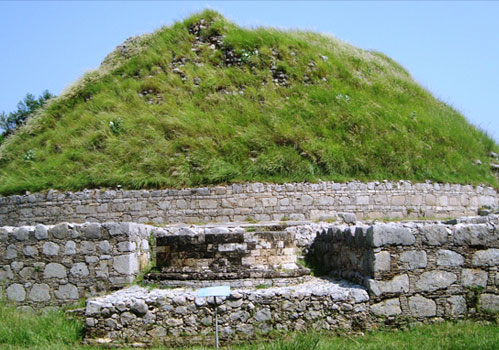
Buddhist Sites In Pakistan: Taxila
The rich Gandhara heritage is widely distributed in Chabula Top, Shah Gki Deri, Charsadda, Sheikhan Deri, Takht-Bahi, Shri Bahloul, Jamal Garhi, and Gango Deri in Peshawar and Mardan. In the Taxila valley, Serikop, Dharmarajika, Bermond, Bhalar, Sirsukh, Biblical, Julian, Mohra, and Moradu are the main sites, and there are still hundreds of towers and monasteries. However, most of these sites are not restricted and are thus vulnerable to theft and illegal excavation.
The Taxila Museum in Pakistan houses one of the finest collections of Buddhist artefacts in Pakistan. The Taxila Museum houses an impressive collection of antiquities and artworks from the Gandharan civilization. The Taxila Museum houses the Buddha’s tooth and bone relics.
The art at the museum revolves around the life story and personal image of the Buddha. The stories are engraved in stone, and photos of the Buddha’s life are preserved: his birth, his lavish life before enlightenment, his departure to seek enlightenment, and post-enlightenment scenes such as Buddha taming mad elephants and even Nirvana Buddha. There are about 24 stone-carved Buddhist sites and more than 1,400 stone tools.
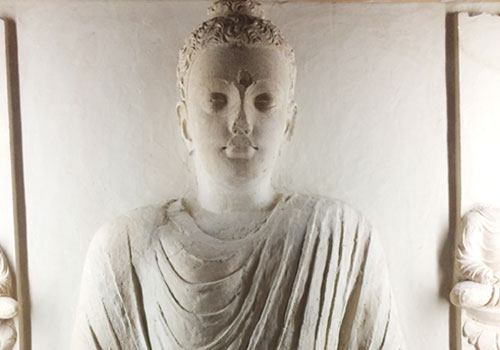
Stupa at Taxila Meusum
These precious relics of the Buddha are kept by the Great Ashoka and are now in the Taxila Museum in Pakistan. Recently, the government sent them to travel to other countries.
One of the most famous fasting Buddha statues is displayed at the Lahore Museum in Pakistan. Sakyamuni fasting in the third and fifth centuries. After Shakyamuni attained enlightenment in Bodhgaya, he meditated and fasted for forty-nine days. Thus, showing slight condescension to his enlightenment and status as a yogi gives complete control over his body. The Lahore Museum has an extensive collection of Buddhist artefacts. During its stay in Punjab, the Lahore Museum houses a treasure trove of Buddhist art from ancient Indo-Greek and Gandharan kingdoms. The museum has well-preserved miniature pagodas and many historical relics, but the crown jewel is the “fasting Buddha” of the Gandhara era.
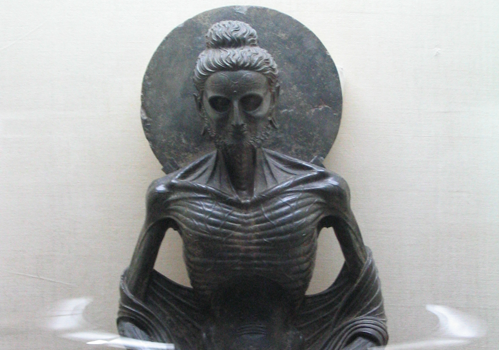
Fasting Buddha at Lahore Museum
Khyber Pakhtunkhwa (KPK) province has a vast Buddhist monastery site called Takht I Bahi. Tourists often visit the place in person, one of my favourite Buddhist-related places in the country. It is located near the city of Mardan and is impressively situated on a scenic green hill. The monastery is fortunate to be the largest Buddhist monument in the Gandhara region and is included on the UNESCO World Heritage List.
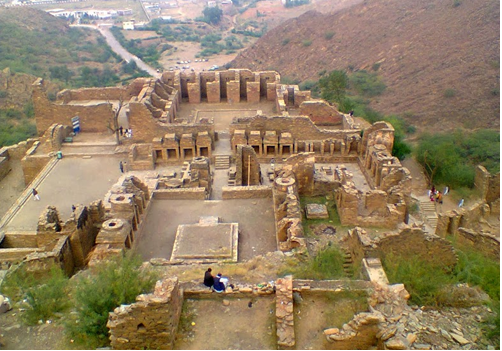
Top Buddhist Sites in Pakistan: Takht i Bahi KPK
In Swat, KPK, one can find many towers and monasteries around the picturesque mountains and valleys. Nicknamed Pakistan, Switzerland’s Swat Valley was once home to as many as 1,400 monasteries. The famous Gandhara School of Sculpture is also located in the valley.
Amluk Dara Stupa is near Nawagai village in Swat. The most famous stupas in Swat Valley include Putkara Stupa near Mingora, Amlok Dara Stupa near Nawajai Village, and Chingardar Stupa in Chingardar Village. In addition, the Swat Valley also houses an iconic 7th-century seated statue of a seated Buddha in Jahanabad, carved into the rock, which was disfigured thanks to the help of Italian archaeologists but was removed in 2016 for repair. This rock statue is one of the most significant carvings in the area, and ancient records depict the area as a major Buddhist site.
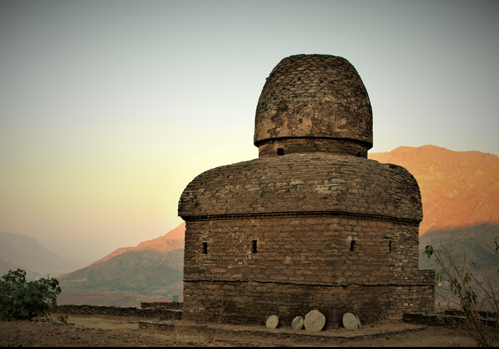
Buddhist Sites In Pakistan: Stupa in Swat Valley
Traces of Ashoka’s decrees throughout the Indian subcontinent can also be found in Pakistan. These decrees are important to Buddhists because they come directly from Ashoka himself – one of the most important rulers in Buddhist history. Mansehra Rock Edicts are 14 ordinances carved into the rock of the city of KPK Mansehra, dating back to the 3rd century BC. These decrees inform the public about Ashoka’s piety laws and the development of Buddhism.
Instead, there are many Buddhist wonders in one of Pakistan’s most stunning regions, Gilgit-Baltistan. For example, Manthal Buddha Rock is located near Skardu. The rock is engraved with Buddha statues dating back to the eighth century. In addition, the 30-foot-high Hunza sacred rock dating back to the first millennium AD can be found in Hunza, Gilgit-Baltistan.
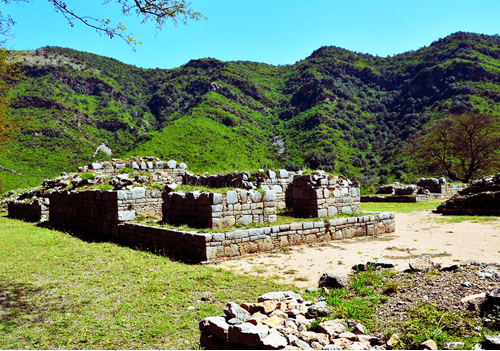
Buddhist Sites In Pakistan: Stupas in Gilgit Baltistan
Mohenjodaro is the best-preserved archaeological site in Pakistan. This place is a subtle symbol of Pakistan’s authentic culture and heritage. The infrastructural and architectural trends introduced by the ancient Pakistanis are visible and are still being pursued. Buddhist relics have also been found in Sindh. A stupa can be found at the Mohenjo-Daro Historic Archaeological Site. Mohenjodaro is home to the ancient Indus Valley civilization and is considered one of the world’s oldest and most progressive cities. The pagoda here towers into the sky and overlooks the ancient city. In addition, the National Museum of Pakistan (Karachi, Sindh) also has some fine Buddhist artefacts and statues. Other Buddhist sites can be found in Balochistan and Pakistan’s Azad Kashmir region.
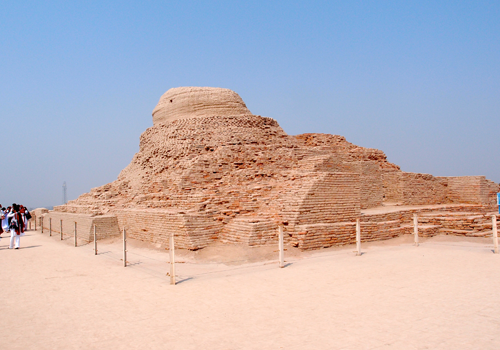
Buddhist Sites In Pakistan: Mohen jo Daro
What draws tourists to these places is the connection to Buddhism and the splendour of the area where these towers, stone carvings, monasteries, and city centres are located. Picturesque mountains and hills, sparkling lakes, rushing rivers, and seemingly endless lush trees and foliage hold epics from the Buddhist tradition.
Pakistan needs to promote its rich culture and history so that the world can see and preserve its wonderful Buddhist heritage. If tourism expands further, Pakistan could become a new hub for Buddhist tourism.
Since 2017, Saba Ghani has been serving as the talented and dedicated chief content writer for Pakistan Tour and Travel & EMHI Solutions. With her exceptional writing skills and in-depth knowledge of the travel industry, she has been instrumental in crafting engaging and informative content that captivates the audience. You can catch her at saba@pakistantourntravel.com or Twitter
12Years of relentless tourism Services in Pakistan